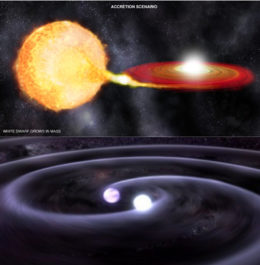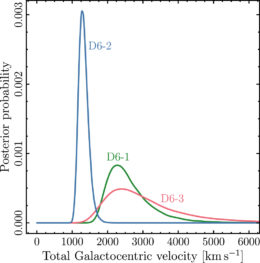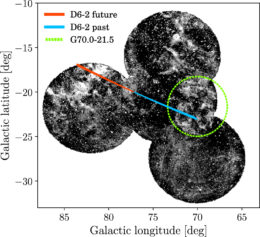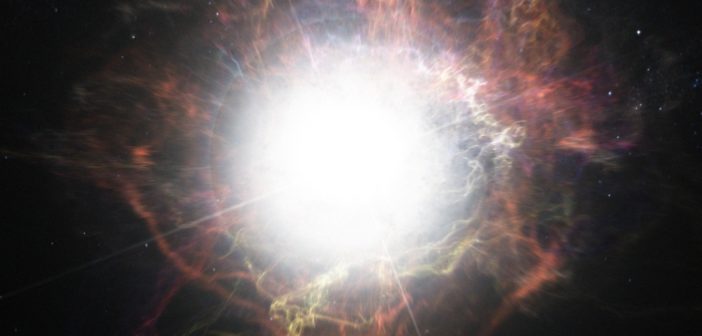A recent study has discovered three of the fastest stars known in the Milky Way. But these stars may be more than just speeders — they might also be evidence of how Type Ia supernovae occur.
Seeking a Source

Two competing theoretical models for the progenitors of Type Ia supernova explosions: the single-degenerate model (top) and the double-degenerate model (bottom). Today’s study focuses on a double-degenerate model in which a one white dwarf explodes in a binary pair, flinging the other one out into space. [NASA/CXC/SAO and GSFC/D. Berry]
Led by astronomer Ken Shen (University of California, Berkeley), a team of astronomers has explored one particular model for Type Ia supernovae further: the “dynamically driven double-degenerate double-detonation” model — or D6, for short. In this scenario, a pair of white dwarfs orbit each other in a binary system. Two back-to-back detonations then cause one of the white dwarfs to explode as a supernova while the other white dwarf survives and is flung free of the explosion site.
Shen and collaborators note that if the D6 model proves to be the primary means of producing Type Ia supernovae, then there’s an observable outcome: there should be white dwarfs speeding throughout our galaxy that were suddenly liberated by the supernova explosions of their companions.

Posterior probability distributions for the total galactocentric velocities for estimated for the three hypervelocity white dwarf candidates: D6-1, D6-2, and D6-3. [Shen et al. 2018]
Hunt for Speeders
Based on the estimated supernova rate in our galaxy and the properties of binary white dwarfs, Shen and collaborators predict that there should be ~30 hypervelocity white dwarfs within ~3,000 light-years of us. But how to spot these compact stars speeding across the sky? With one of the best tools in the business: Gaia.
Shen and collaborators combed through the numbers from the Gaia mission’s second data release, which presents the astrometric parameters of more than a billion stars across the sky. In this treasure trove of information, they discovered seven candidates that they then followed up with ground-based observations. After ruling out four as ordinary stars, the authors were left with three candidate hypervelocity white dwarfs.
Associated Remnant?

The past (blue) and future (red) trajectories calculated for the hypervelocity white dwarf candidate D6-2 suggest it was previously located coincident with the G70.0–21.5 supernova remnant (green dashed circle). [Shen et al. 2018]
Two of the candidates show no sign of having traveled from a nearby remnant — not necessarily surprising, as the remnants could be very faint, or even have already dissipated completely. But the third candidate can be tracked back to a location within the faint, old supernova remnant G70.0–21.5.
While not yet a smoking gun, these hypervelocity white dwarfs represent important support for the D6 model. And continued follow-up of additional candidates — as well as new candidates discovered in future Gaia releases — may further confirm this model for how Type Ia supernovae occur.
Citation
“Three Hypervelocity White Dwarfs in Gaia DR2: Evidence for Dynamically Driven Double-Degenerate Double-Detonation Type Ia Supernovae,” Ken J. Shen et al 2018 ApJ 865 15. doi:10.3847/1538-4357/aad55b

7 Comments
Pingback: Speeding White Dwarfs May Point to Past Explosions – CityGov
Pingback: Speeding White Dwarfs May Point to Past Explosions – AstroBrief
Pingback: Enanas blancas veloces posiblemente señalan a explosiones en el pasado – Observatori Astronòmic
Pingback: Noviembre 2018 – Observatori Astronòmic
Pingback: Enanas blancas veloces posiblemente señalan a explosiones en el pasado « SEDA / LIADA - RedLIADA - Cursos LIADA - Cielo del Mes - Fenómenos Astronómicos - RELEA
Pingback: Finding Just the Right Type of Detonation
Pingback: From AAS NOVA : “Finding Just the Right Type of Detonation” | sciencesprings